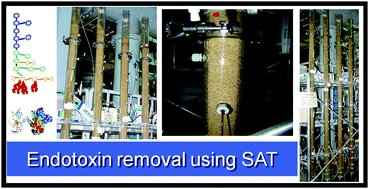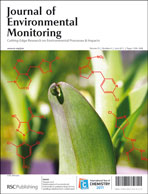Soil-aquifer treatment (SAT) of wastewater is an increasingly valued practice for replenishing aquifers due to ease of operation and low maintenance needs and therefore low cost. In this study, we investigated the fate of endotoxins through laboratory-scale SAT soil columns over a four month period. The effluent of rapid sand filtration was run through the columns under gravity flow conditions. Four SAT columns were packed with four different filter materials (fine sand, medium sand, coarse sand and very coarse sand). The effluent of rapid sand filtration (average dissolved organic carbon (DOC) = 4 mg l−1 and average endotoxin concentration = 4 EU ml−1) was collected from a domestic wastewater treatment plant in Sapporo, Japan. DOC removal ranged from 12.5% to greater than 22.5% during the study, with DOC levels averaging 3.1 and 3.5 mg l−1 for the SAT columns packed with different soils. Endotoxin transformation exhibited different profiles, depending on the time and soil type. Reduction in endotoxin concentration averaged 64.3% and was as high as 86.7% across the soil columns 1, 2, 3 and 4, respectively. While DOC removal was gradual, the reductions in endotoxin levels were rather rapid and most of the removal was achieved in the top layers. Soil with a larger grain size had lower efficiency in removing endotoxin. Tests were performed to evaluate the transformation of organic matter showing endotoxicity and to determine the mechanisms responsible for changes in the structural and size properties of dissolved organic matter (OM) during SAT. Dissolved OM was fractionated using Sep-Pack C18 Cartridges into hydrophobic and hydrophilic fractions. Dialysis tubes with different molecular weight cut-offs were used to perform size fractions of OM showing endotoxicity. Evaluation of the transformation of organic matter showing endotoxicity during SAT indicated that both hydrophobic and large molecules were reduced. Moreover, experimental findings showed that adsorption test data fit to the Freundlich isotherm and were affected by the particle grain size with higher adsorption capacity for fine and medium sand.

You have access to this article
 Please wait while we load your content...
Something went wrong. Try again?
Please wait while we load your content...
Something went wrong. Try again?


 Please wait while we load your content...
Please wait while we load your content...